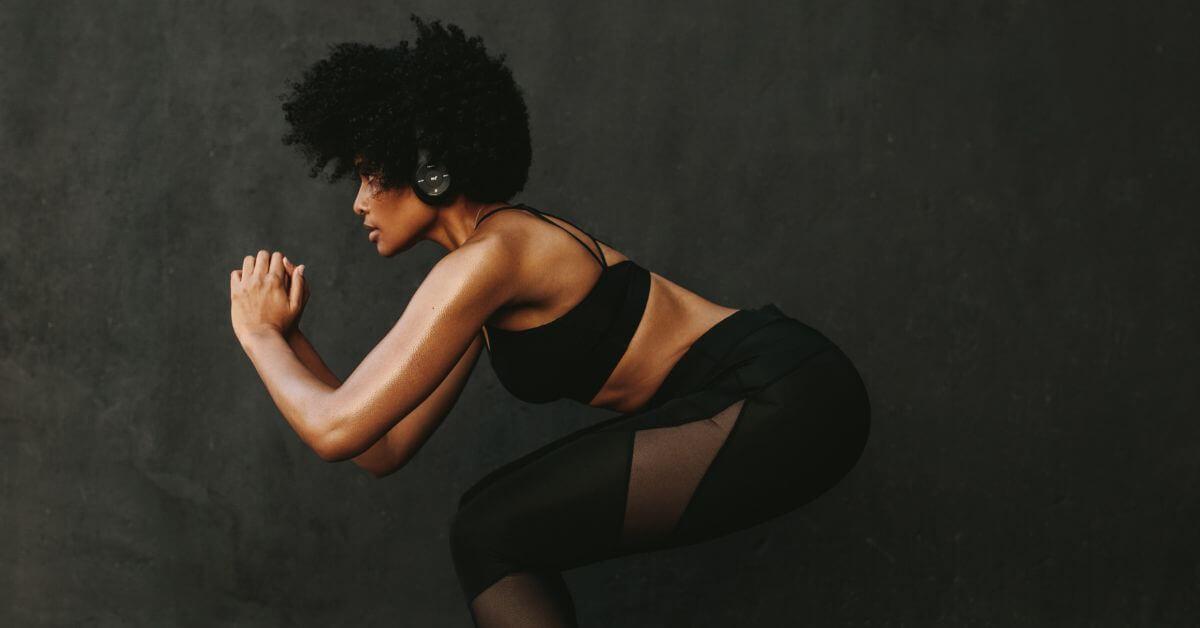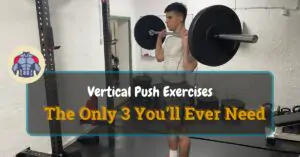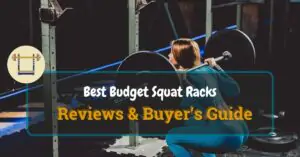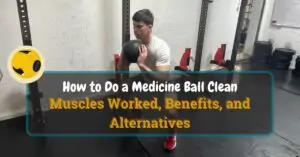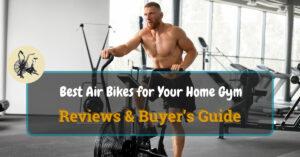Functional leg strengthening exercises are essential to improving your daily tasks regarding growing leg strength. Incorporating a functional leg workout can enhance your overall performance and make everyday movements more efficient.
Table of Contents
ToggleAlong with making daily tasks like getting in and out of your car easier, they also help you get better at activities you enjoy, such as swimming, running, etc.
In contrast to isolation exercises, which can lead to muscle imbalance and raise your risk of injury, functional training simulates daily activities by having your body move in all planes of motion. Functional leg day routines are a perfect example of this approach, ensuring balanced development and injury prevention.
Our Recommended Functional Leg Equipment
Yes4All Vinyl-Coated Kettlebell
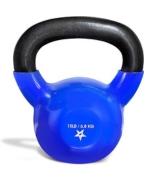
- Built to last of solid cast
- Vinyl-coated to prevent corrosion
- High-quality slightly textured handle
Start Building Your Dream Body Today
Ready to elevate your fitness game without falling into the trap of dull, repetitive routines that just don’t deliver? Imagine sculpting your ideal physique and boosting your health, all while still enjoying life’s pleasures, like those irresistible weekend getaways and your aunt’s legendary cheesecake. With our online fitness and nutrition coaching service, you don’t have to compromise. Dive into a personalized fitness journey that blends perfectly with your lifestyle, not against it. Book your completely free discovery consultation today, and take the first step towards a transformation that doesn’t require giving up the joys of life.

“I was skeptical about online fitness coaching, but Functional Body Savage completely changed my perspective. Vanja and Radomir’s personalized approach and attention to detail have helped me achieve goals I never thought possible. I’m stronger, more confident, and grateful for their guidance.”
Emily Thompson, San Francisco, CA
Learn More About Our Online Coaching ServiceQuick Summary
- When working your legs, you should complete 3 sets of 8–12 repetitions.
- A well-rounded functional lower body workout can help you target different muscle groups and improve overall strength and mobility.
- You should work your legs 3 times per week, with each workout taking 15 to 20 minutes and focusing on different parts of the legs.
- Incorporating unique leg exercises into your routine can keep your workouts engaging and challenging.
- Any of the exercises must be performed after a suitable warm-up and cool-down.
14 Functional Training Leg Exercises
Take inspiration from this list of the best leg exercises when designing your next leg workout.
1. Back Squat
The back squat is a bilateral structural exercise that promotes the development of total-body strength. It’s a staple in any functional leg training routine due to its effectiveness in building lower body power.
Strong hamstrings, quads, moderate midline stability, and ankle mobility are requirements for squats. Oh, and let’s not forget that a back squat is one of the best compound exercises.
The back squat is one of the best total-body movements you can incorporate into your leg day training split.
Leg strength, mobility, core stabilization, and posture are all greatly enhanced by the squat, which enhances your overall athletic performance.
For a more detailed approach regarding proper squat technique and form, read our guide on how to do squats correctly without injuring or reducing your performance.
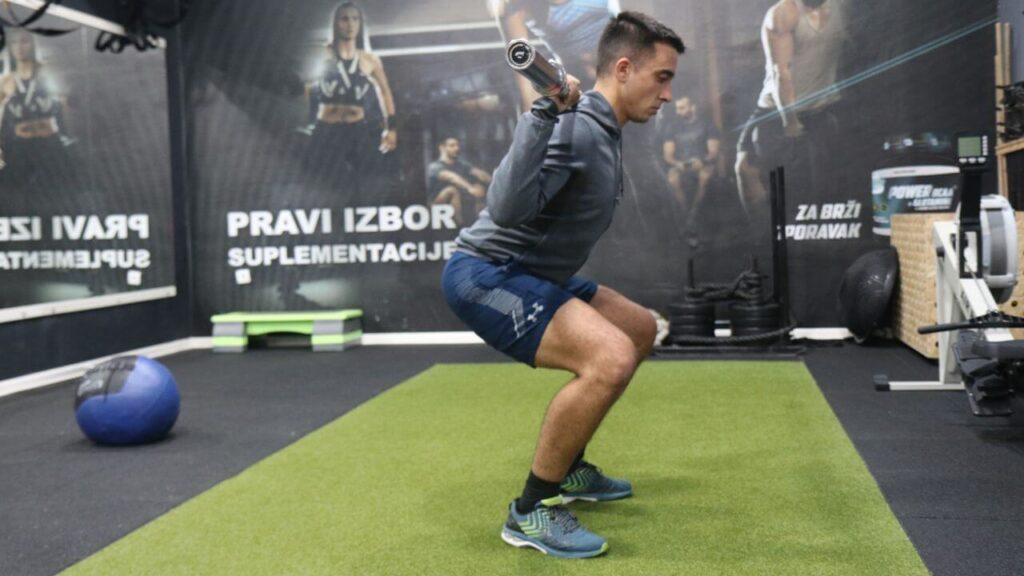
How to Perform a Squat
- While everyone’s stance will be different, it is generally recommended that you stand with your feet hip-width apart, your toes slightly pointed outward, your spine neutral, your chest open, and your shoulders back.
- You should also make sure that your heels are firmly planted because as the movement progresses, your weight will shift to your heels.
- Bend your knees with your chest wide and lifted till parallel to the ground while sending your hips back as if you’re attempting to sit in an unseen chair.
- Push straight up to a standing posture by engaging your heels.
2. Front Squat
The front squat is a lower-body exercise such as the back squat. This exercise is a key component of functional training for legs, helping to build strength and improve balance.
Your exercise will feel different, and you will focus on various muscles as you switch the weight from your back to your front.
While it’s true that the front squat works every major muscle in your legs, research indicates that it also effectively works your glutes, back, shoulders, and abs, among other key muscle groups throughout your body.
Are you interested to learn about a similar exercise that also targets quads effectively? Then check out our guide on landmine hack squats to enhance your leg workout routine further.

How to Perform a Front squat
- While standing erect, keep the back tall and the spine long. Your weight is distributed over the middle of your feet, and the heels stay firmly planted. Avoid moving back into the heels or forward onto the balls of the feet.
- Deepen the squat by lowering the body. When you are in the lowest position, your hamstrings will almost touch the back of your calves. In order to stop the bar from rolling forward, keep your chest up and your elbows raised at bar height (if possible).
- Slowly and carefully reverse the squat, extending the knees and hips at the same time.
- Lift until the body has returned to the starting position.
3. Good Mornings
To the untrained eye, a good morning workout appears to be a chiropractor’s worst nightmare.
Nonetheless, the good morning can be an excellent exercise for enhancing your back health if performed with proper form and a stable spinal alignment. This exercise is part of functional leg workouts that target the posterior chain.
It helps to slightly stretch and support your hamstrings while strengthening your lower back muscles and core.
Office workers, weightlifters, athletes, and marathon runners all benefit from this move.
Maintaining moderate movement, rigid form, and lightweight is the best way to get the advantages and prevent self-harm.
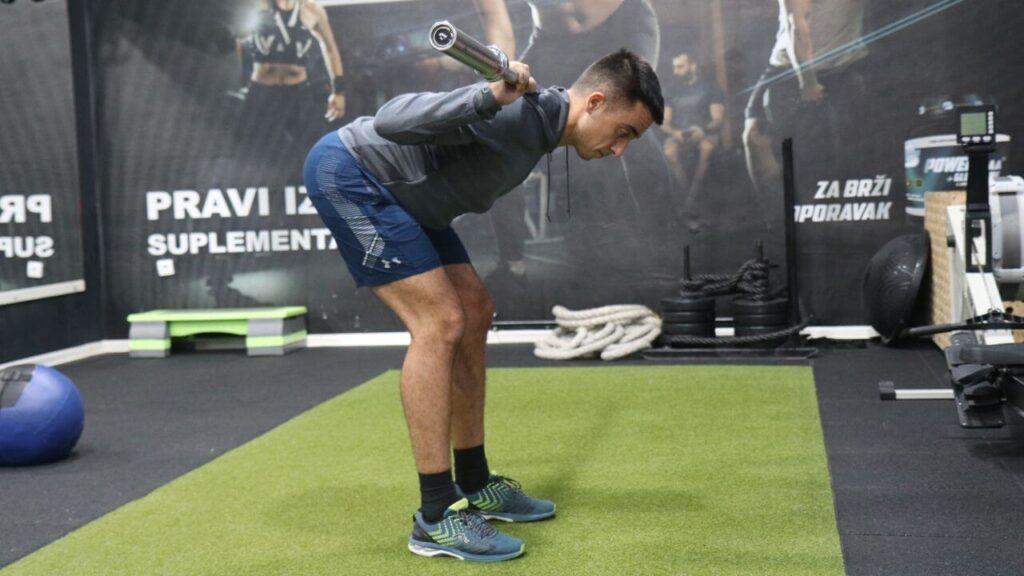
How to Perform a Good morning
- With your feet shoulder-width apart, your knees slightly bent, your toes pointed forward, and two dumbbells in each hand, you should be in the starting position.
- Dumbbells should be stacked on your shoulders, with the back of the dumbbells pointing toward your shoulder blade and the base of the neck as the point of contact. Alternatively, you can do this as a front-loaded move by holding a single dumbbell at shoulder height with one hand on each side.
- Hinge at your hips to bring your torso close to the floor while maintaining a neutral spine and a strong core.
- Go back to the starting position. That is one rep. Finish three sets of 10–12 repetitions.
4. Romanian Deadlift
The Romanian deadlift differs slightly from the standard deadlift. It’s a crucial exercise in lower body functional exercises, focusing on the hamstrings and glutes.
Although Romanian deadlifts stress and target the hamstrings rather than the glutes, both exercises are one of the best leg exercises for strength and muscle hypertrophy in the posterior chain muscles.
Due to the biomechanical differences in exercise technique, conventional deadlifts target and recruit the gluteus and rectus femoris muscles more than the Romanian deadlift.
This is because the conventional deadlift starts and finishes more in a sitting position than the Romanian deadlift, which has significantly more knee and hip flexion.
For those looking to enhance posterior chain development further, the toes elevated RDL variation offers a superb muscle activation that primarily intensifies hamstring and glute engagement.
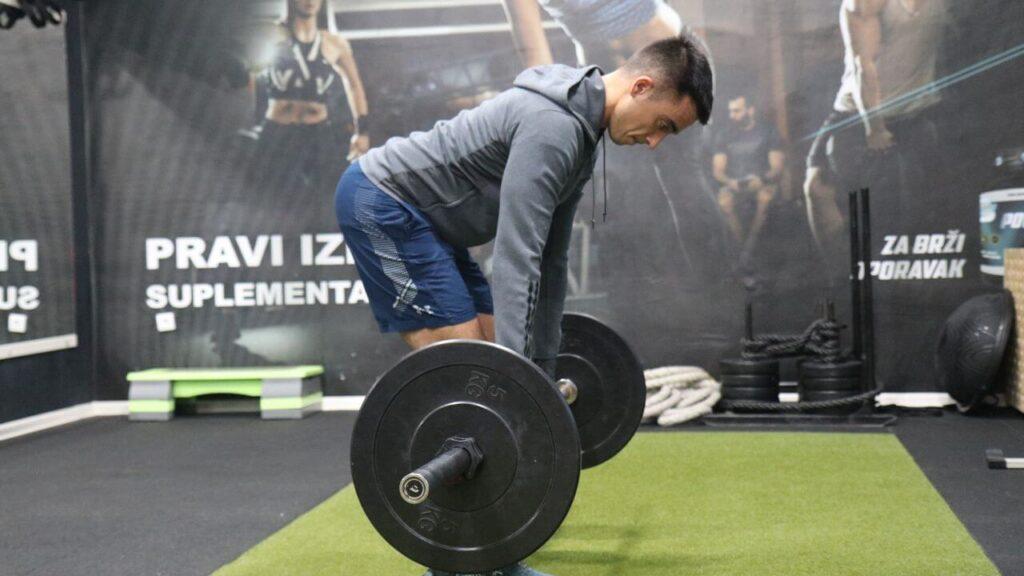
How to perform a Romanian deadlift
- Put your feet shoulder-width apart and stand tall. With your hips pushed back, take hold of a weighted barbell and hold it precisely in front of your thighs with your hands slightly wider than your thighs.
- Starting with your knees slightly bent at a 15-degree angle, steadily reduce the weight while maintaining close contact with your legs, hunching at the hips, and maintaining a straight back. As you maintain a straight torso, keep your core firm and engaged.
- After you feel a tiny stretch in the hamstrings, usually just past the knees, lower the weight. Maintain an erect posture with straight arms, rounded shoulders, and shoulder blades drawn back against your spine.
- Push your hips forward, then bring the weight back up to a standing position with the help of your hamstrings.
5. Walking Lunges
Walking lunges are a variation of the static lunge exercise.
Instead of standing back upright after performing a lunge on one leg, as you would in a static bodyweight lunge, you “walk” forward by lunging out with the other leg.
The movement continues for a set number of reps.
Walking lunges strengthen the leg muscles, core, hips, and glutes. This exercise is a staple in functional lower body exercises for its ability to enhance stability and strength.
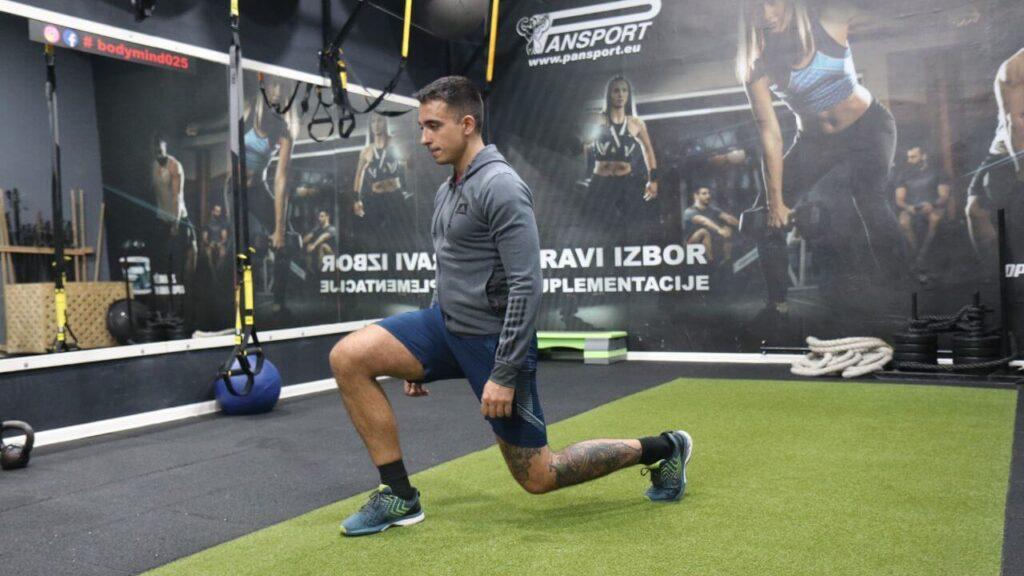
How to Perform a Walking Lunge:
- Put your feet shoulder-width apart and stand straight up. You can keep your hands on your hips or at your sides.
- Using your right leg, advance while placing weight on your heel.
- In a lunge position, flex the right knee and lower it until it is parallel to the floor. Take a brief pause.
- Repeat the exercise on the left leg, moving your left foot forward without moving your right leg. Pause when your left leg is in a lunge position and parallel to the floor.
- Continue this motion, stepping forward and lunging with alternate legs.
- 10 to 12 repetitions per leg. Make two to three sets.
6. Lateral Lunge
The unilateral exercise known as the lateral or side-stepping lunge targets the frontal plane.
Your body needs to train in the other planes to ensure it is strong, mobile, and healthy enough to move properly because so many of our daily movements are forward and backward.
It trains one leg at a time, much like all lunge exercises, which reduces imbalances and improves movement and athletic performance.
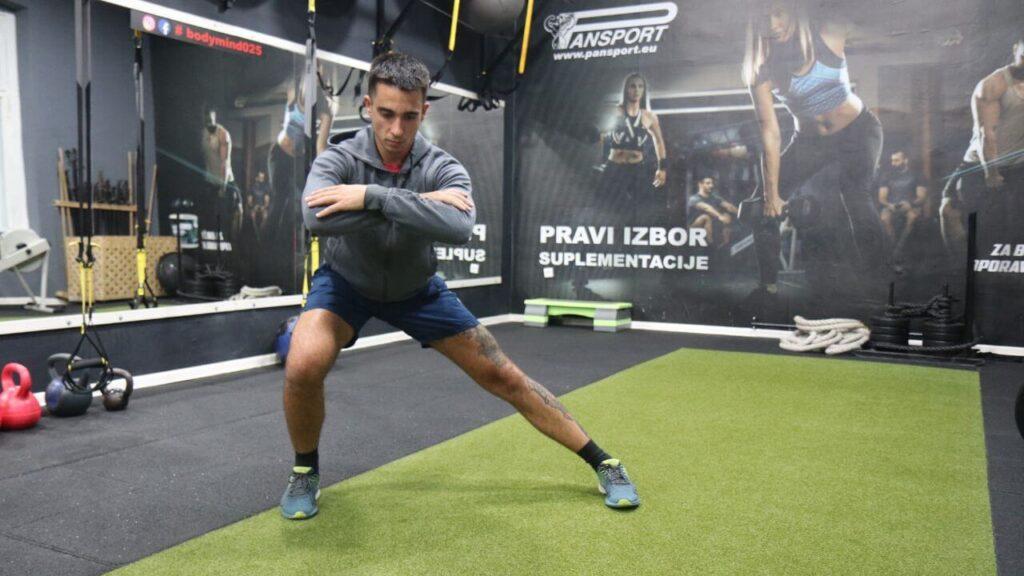
How to perform a Lateral Lunge:
- Start by placing your feet farther apart than hip distance.
- While erecting your torso and sitting back into your left hip, bend your left knee. Lower yourself onto your left leg until your knee is at a 90-degree angle while maintaining as much straightness in your right leg as possible.
- Repeat by lifting yourself back up to the starting position. Rep each side for the appropriate number of times.
7. Reverse Lunge
You can train unilaterally by exercising only one side of your body simultaneously with reverse lunges.
Unilateral exercises can be useful weapons in your training arsenal for addressing muscle imbalances and aiding in the symmetry-building of your physique.
Working on one side at a time can help you improve your balance and coordination, which will benefit your athletic ambitions.
You’ll work the majority of the significant muscles in your lower body by concentrating on your quads, hamstrings, and glutes.
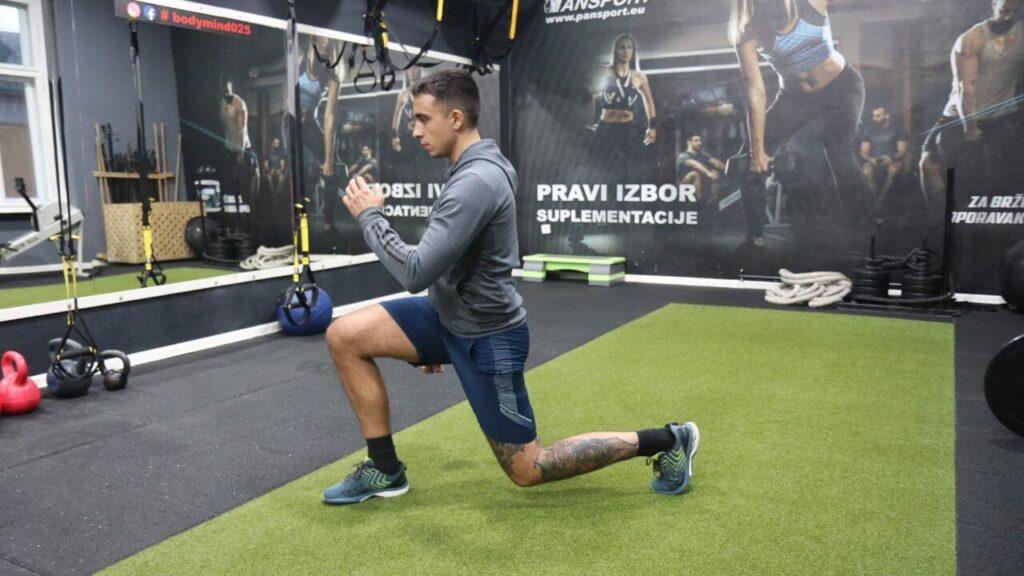
How to Perform a Reverse Lunge:
- With your hands on your hips, stand straight.
- With your left foot, advance backward a good distance.
- Your right knee should be directly over your ankle as you lower your hips until your right thigh (front leg) is parallel to the floor. Your left heel should be elevated, and your left knee should be bent at a 90-degree angle, pointing toward the floor.
- Bring your left leg forward to finish one rep and plant your right heel firmly on the ground. Then, rise again.
- Step back with your right leg while switching legs.
8. Overhead Lunge
Lunge is one of the best leg exercises that work the glutes and quadriceps.
They, however, also engage your core, hamstrings, and calves, in addition to all the other lower body muscles.
The overhead lunge is one of the most useful and effective exercises for developing total body strength.
With the bare minimum of tools, you may increase your strength, mobility, core strength, and stability.
This advanced plyometric exercise may strengthen your upper and lower bodies, raise your peak power production, improve your proprioception, and strengthen your core.
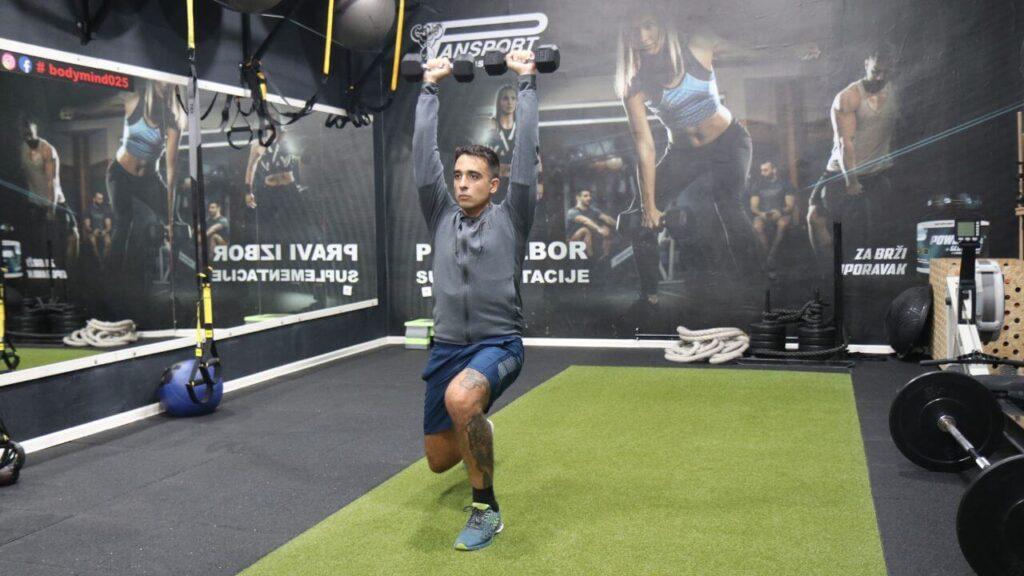
How To Perform an Overhead Lunge
- Press a weight plate above your head while standing with your feet together.
- Move your left leg forward into a deep lunge while maintaining your overhead weight. The torso ought to hold its position.
- Put the front foot down first, then pivot to the starting position.
- Repeat as many as you need to.
Our Recommended Functional Leg Equipment
Yes4All Vinyl-Coated Kettlebell

- Built to last of solid cast
- Vinyl-coated to prevent corrosion
- High-quality slightly textured handle
9. Step-Up
Step-up exercise is excellent leg exercise, and adding dumbbells increases the muscles’ strain.
It may be altered to create a secure and efficient workout for individuals of all fitness levels.
It can be used in most exercise regimens to increase gluteal and upper leg strength.
Because you must control the weight as you go up and down, forward and back, this exercise enhances balance, stabilization, and proprioception.
Step-up exercises are great for developing quadriceps strength.
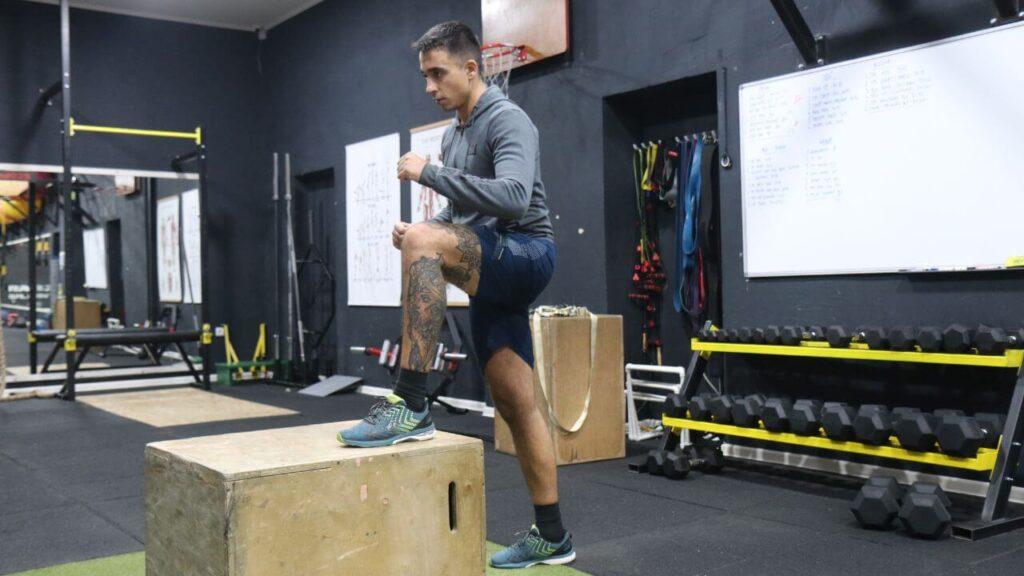
How to perform a Step-up:
- Standing with a bench or other elevated surface about one foot in front of you. Hold a dumbbell in each hand if you wish to perform a weighted step-up.
- Step your entire right foot onto the bench, pushing up through your heel to bring your left foot to meet your right foot. For added difficulty, elevate your left knee.
- Take a step down with your left foot to get back to the beginning position.
10. Glute Bridge
A glute bridge is a physical exercise that helps to strengthen the gluteus muscles and hamstrings.
Glute bridges are done by laying on your back with both feet planted on the ground and lifting your pelvis.
It can help to increase hip flexibility and lower back health. Lower body functional workout routines often include exercises like the glute bridge to improve hip mobility and core strength.
Glute bridges are an effective exercise to include in your workout routine if you spend long hours sitting in a chair, which can limit your hip flexor mobility.
They’re also a popular warm-up exercise that prepares for hip flexibility.
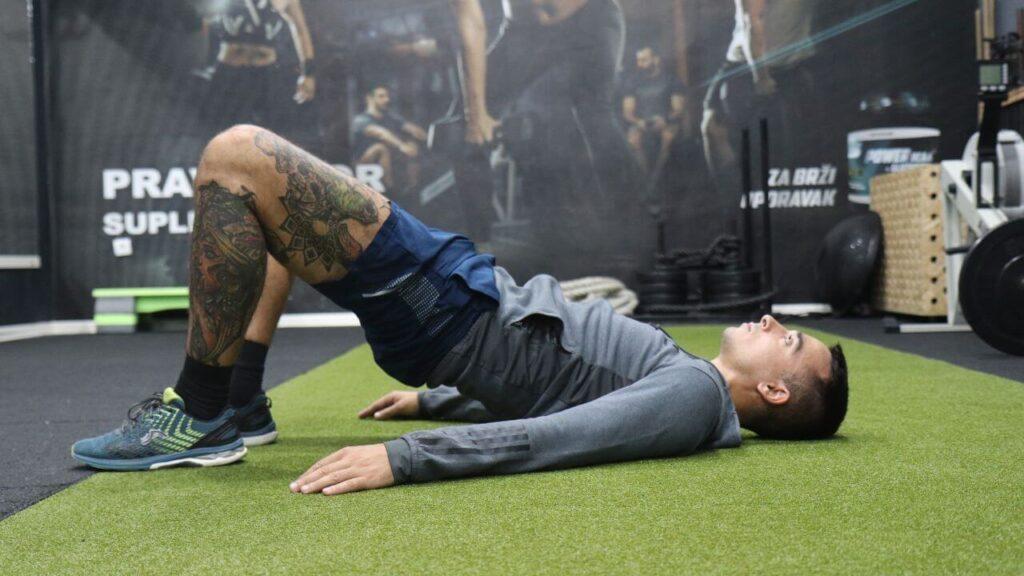
How to perform a Glute Bridge
- Lie on your back with your knees bent and your feet flat on the ground. Your feet should be hip-width apart with your toes pointed straight ahead. The palms of your hands should be facing the ceiling while you hold your arms by your sides.
- As you pull your hips up toward the ceiling, tighten your abs and glutes.
- As high as you can without arching your back, lift your hips. Your body should be straight from your knee to your hip and shoulder as you elevate your hips.
- In the top position, contract your glutes as hard as possible and hold for two seconds.
- Maintain tension in the glutes and abs as you slowly descend your hips to the floor.
11. Goblet Squat
A goblet squat is a full-body movement that involves squatting while holding a single free weight in front of your chest, such as a dumbbell or kettlebell.
A goblet squat targets the core muscles in your upper body and the lower body muscles of your glutes, quads, hamstrings, and calves.
You become ready for different squat variations with goblet squats.
The goblet squat is an excellent technique to develop strength for a more demanding exercise like a front squat or back squat, which uses heavier barbells because it allows you to use lesser weights like dumbbells and kettlebells.
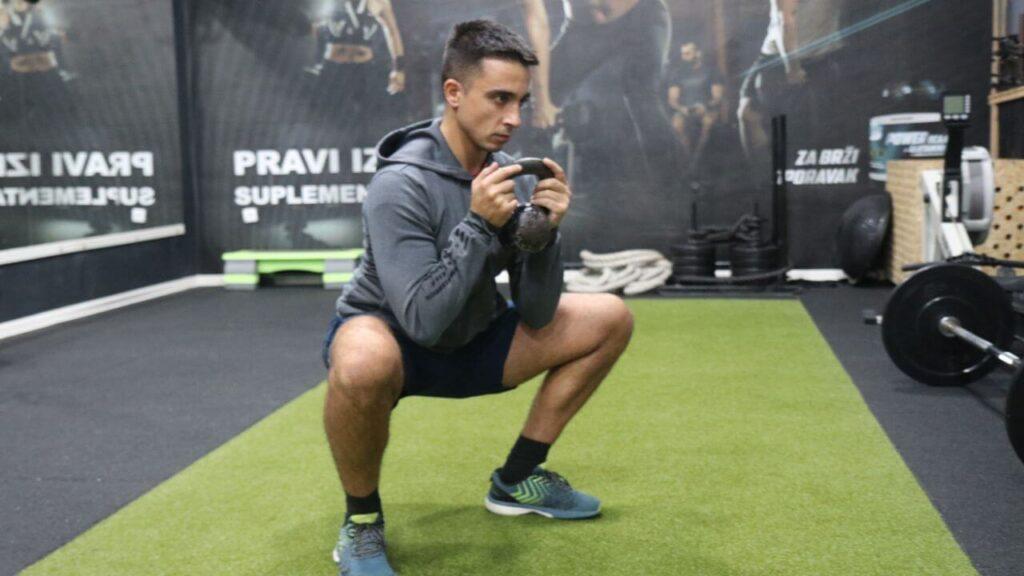
How to Perform a Goblet Squat:
- Hold a dumbbell vertically and place both hands beneath the top of the weight to begin. Place the weight in that position and maintain contact with your chest throughout the exercise.
- Sit back into your hips and flex your knees as you squat. As far as your mobility will allow, keep your torso up and squat down.
- Return to the beginning position by pushing through your heels.
12. Hip Thrust
The hip thrust, also known as the hip thruster, is a glute bridge variation carried out with a barbell while lifting the body off the ground.
Compared to other lower-body exercises, it more effectively targets the gluteal muscles.
The hip thruster works the gluteal and hamstring muscles to increase hip extension.
Certain well-liked hip thruster variations also work the abductors, the muscles that encircle the sides of the hips.
You’ll need to utilize a circular resistance band to carry out these exercises.
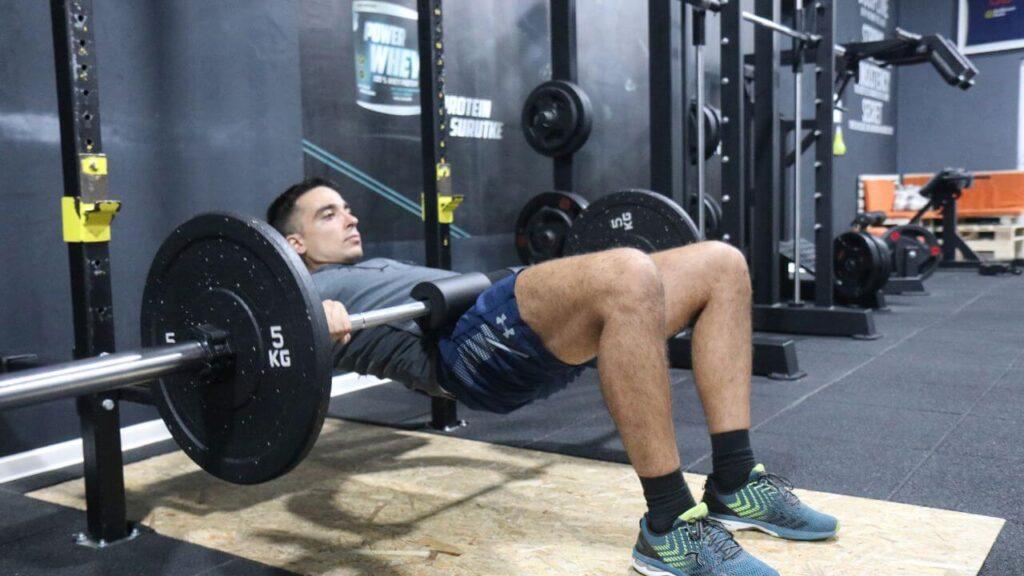
How to Perform a Hip Thrust:
- Put a barbell, dumbbell, or plate on your hips and sit on a raised surface like a bench or sofa. You will need to use your hands to support the weight throughout the movement.
- To position yourself, slide your back down the bench while keeping your feet flat and shoulder-width apart. The bench should be placed directly beneath your shoulder blades with your legs at a 90-degree angle.
- Maintain a chin tuck while lowering your butt to the floor. Your torso should descend while your feet stay put, halting when it makes a 45-degree angle with the ground.
- Push up through your heels to get your thighs back to being parallel to the floor. Return to the beginning posture after squeezing your glutes at the peak.
13. Bulgarian Split Squat
The Bulgarian split squat is a version of the single-leg squat. In contrast to a standard barbell squat, it transfers all the weight and strain from your lower back to your legs.
With the stabilizing leg elevated behind you during a Bulgarian split squat, you have more depth and range of motion, resulting in increased muscle hypertrophy and increased strength in your glutes and quads.
Bulgarian split squats are essential for developing a larger barbell back squat and stronger quadriceps, glutes, and midline stability.
They also provide a fantastic range of motion for the hip flexors.
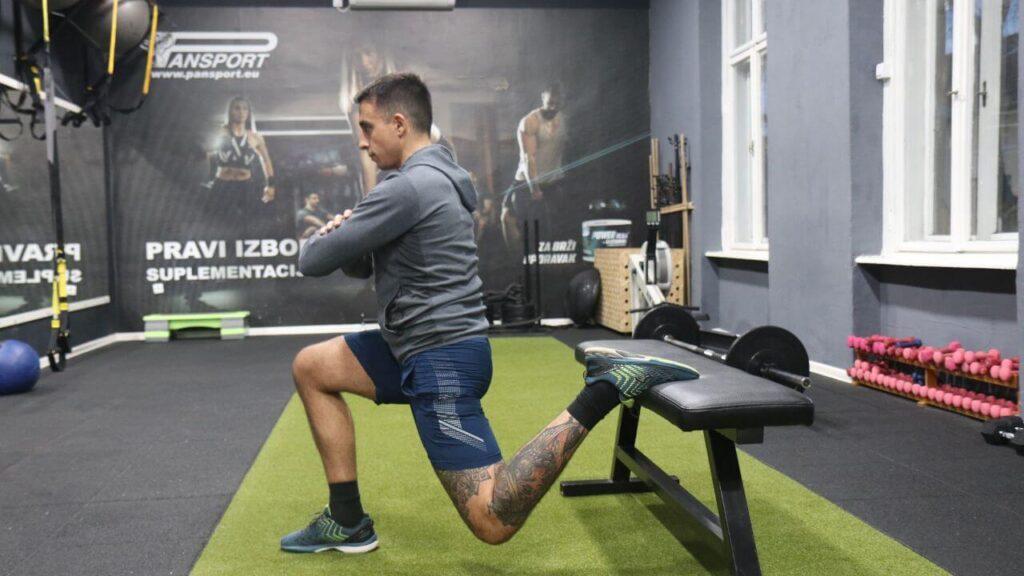
How to Perform a Bulgarian Split Squat
- Place your feet hip-width apart to begin. Put the left foot behind the body and the right leg on a bench or box slightly below knee height.
- Start to lower yourself into a lunging position while keeping your shoulders stacked squarely over your forward-facing hips. Hold a dumbbell or kettlebell vertically on each side of your torso with both hands.
- Lower your left leg to the floor while maintaining a straight back.
- As you descend, keep your chest open and check that your front knee isn’t sticking out in front of your toes.
- As soon as your left knee begins to sag, push the top of your left foot into the box to stand back up while pulling back on your right knee.
14. Single-Leg Deadlift
The single-leg deadlift is a straightforward but efficient exercise for balance improvement and butt muscle building.
Although amateurs can perform this without weights, it can also be done with a kettlebell or dumbbell.
You can incorporate it into your lower body toning and strengthening program.
This exercise should be performed right after warm-up, at the start of a training session when you are still alert.
Because standing on one leg instead of two places a greater strain on one’s balance, single-leg workouts enhance glute activation.
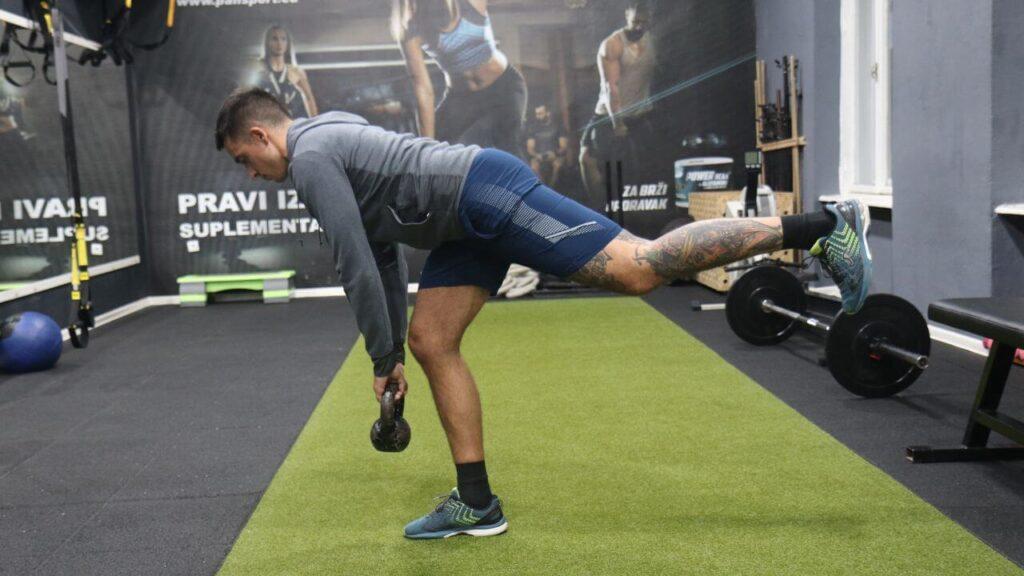
How to perform a single-leg deadlift
- Starting position should be with your feet parallel and hip-width apart. Hold a kettlebell, barbell, or two dumbbells in front of you with your hands down.
- You should put weight on your left leg while leaning your hips forward, and your right leg should be straight behind you.
- Lift your left foot and lean forward to create a “T”-shaped body stance. Your arms must be hanging straight down while you are holding the weight.
- Returning to the starting position, slowly bring your left leg to the right leg, and repeat.
Expert Shares The Ultimate Science-Based Leg Day For Muscle Growth
In a YouTube video, Jeff Nippard, a professional drug-free bodybuilder and powerlifter, shares his approach to programming leg workouts for maximal muscle gains:
“We’re doing five lower body exercises that target the quads, hamstrings, glutes, and calves, and then we finish things off with one exercise for the abs. As usual, we start with a quick general warm-up consisting of 5-10 minutes on the treadmill, and then we do a quick series of dynamic stretches. Then we proceed with the actual workout, which consists of back squats, barbell Romanian deadlifts, walking lunges, seated leg curls, leg press toe press, and then we finish with the decline plate crunch.”
Movement Patterns in a Good Leg Workout
When it comes to designing an effective leg workout, simpler is better.
The basic lower body movements, squats, deadlifts, and lunges, should comprise most of your programming.
These movements inherently focus on the major muscle groups of the legs: the glutes, quads, hamstrings, and calves.
When designing your leg workout, here’s an easy way to break it down:
- Start with a squat movement.
- Move to a hip-hinge movement.
- Add in your single-leg movements.
Once you master these functional movement patterns, plenty of variations and ways to progress will keep you challenged.
“Don’t design a program based on what you like or dislike as a coach or trainer; design a program that works for the athlete.” – Michael Boyle, Strength and Conditioning and Strength Training Consultant
How Many Sets and Reps Should You Do in Your Leg Workout?
You should do 3 sets of 8-12 reps in your leg workout. Choose 3-5 functional training exercises for each leg workout if you’re a beginner wanting to improve overall fitness while keeping things straightforward.
Why only five exercises? You’ll be able to concentrate on those crucial moves and give your best effort. Your workouts may become ineffective if they last for too long.
How Many Times per Week Should You Work Legs?
You should work your legs 3 times per week. Each workout should take 15 to 20 minutes and focus on different parts of the legs.
An intelligent strategy may be to focus on the calves one day, the thighs the next, and the hips the last.
This gives you a much more well-rounded workout and maintains the strength of your entire leg.
But resist the urge to overtrain your legs because this will prevent the body from having the time it needs to rebuild and repair its tissues.
There may even be injury as a result of this.
Stick to three days with recovery in between sessions because your body requires the time to recuperate, making five days of leg training ineffective.
How to Warm Up and Cool Down Properly
A workout cannot be considered effective without an appropriate warm-up and cool-down. Functional leg day workout routines should always begin with a proper warm-up to prevent injury and enhance performance.
To get your heart rate up and your blood flowing during your warm-up, try to start with 5 minutes of easy cardio.
If you have the time, spend 5 minutes releasing soft tissues on the foam roller.
After that, begin a dynamic stretching practice that includes lunges and squats using only your body weight, hip openers, and leg swings.
It’s a good idea to perform a more involved stretching exercise after your workout.
Related Articles:
FAQs
What Is the Most Functional Leg Exercise?
The most functional leg exercise is the back squat. The squat offers significant advantages for posture, core stability, strength, mobility, and flexibility, enhancing your ability to perform better in all athletics areas.
What Is the Best Single Leg Exercise?
The single best leg exercise is a single-leg squat. This requires lowering your complete body as if you were going to sit on a chair while standing with your legs hip-width apart.
How Do You Build Functional Muscles?
You build functional muscles by doing functional exercises. Some exercises you should do are push-ups, chair squats, standard dumbbell rows, and many others.
Our Recommended Functional Leg Equipment
Yes4All Vinyl-Coated Kettlebell

- Built to last of solid cast
- Vinyl-coated to prevent corrosion
- High-quality slightly textured handle
What Is the Best Functional Equipment for the Lower Body?
The best functional equipment for the lower body is free weights.
Free weights will force your stabilizer muscles to activate and allow for the full range of motion.
To build a stronger lower body, read our guide on the best functional training equipment for 2025.
Let me know which functional leg exercise is your favorite and why.
Start Building Your Dream Body Today
Ready to elevate your fitness game without falling into the trap of dull, repetitive routines that just don’t deliver? Imagine sculpting your ideal physique and boosting your health, all while still enjoying life’s pleasures, like those irresistible weekend getaways and your aunt’s legendary cheesecake. With our online fitness and nutrition coaching service, you don’t have to compromise. Dive into a personalized fitness journey that blends perfectly with your lifestyle, not against it. Book your completely free discovery consultation today, and take the first step towards a transformation that doesn’t require giving up the joys of life.

“I was skeptical about online fitness coaching, but Functional Body Savage completely changed my perspective. Vanja and Radomir’s personalized approach and attention to detail have helped me achieve goals I never thought possible. I’m stronger, more confident, and grateful for their guidance.”
Emily Thompson, San Francisco, CA
Learn More About Our Online Coaching Service
